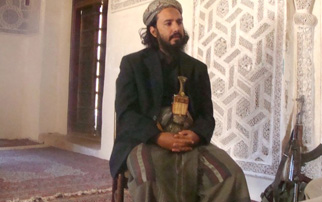
|
| Kaid al Dhahab, the new AQAP emir for Baydah province. Photo from The Yemen Post. |
The US targeted two local leaders of al Qaeda in the Arabian Peninsula in the central province of Baydah today. The AQAP leaders survived the strike, but five fighters are reported to have been killed.
Today's drone strike, the ninth by the US in Yemen this month, targeted Kaid al Dhahab, AQAP's emir in the province of Baydah, and his brother Nabil, who is also a senior leader in the terror group, according to The Yemen Post.
The remotely piloted Predators or the more deadly Reapers targeted Kaid and Nabil as they were traveling in a convoy in Rada'a, a city in Baydah that was under AQAP control earlier this year. The drones killed five AQAP fighters and wounded four more, according to The Associated Press. US intelligence officials told The Long War Journal that Kaid was the target of the strike.
Kaid took control of AQAP in Baydah after his brother, Tariq, was killed in February by another brother, Hazam, a senior tribal leader in the town who was concerned that Tariq's affiliation with AQAP would incur the wrath of the Yemeni government. Before he was killed, Tariq had seized control of Baydah, raised al Qaeda's banner, sworn allegiance to Ayman al Zawahiri, and warned that "the Islamic Caliphate is coming."
Kaid and Nabil were tasked with regrouping AQAP's forces in Baydah after Tariq's death. The two leaders are also the brothers-in-law of slain AQAP leader and ideologue Anwar al Awlaki.
US strikes in Yemen
The US has now carried at least nine drone strikes in Yemen this month. The last confirmed strike took place on May 19. Other recent airstrikes are believed to have been carried out by the US also, but little evidence has emerged to directly link the attacks to the US.
US is known to have carried out 22 airstrikes against AQAP in Yemen so far this year; one in January, six in March, and at least six more in April, in addition to the nine already in May.
Since December 2009, the CIA and the US military's Joint Special Operations Command are known to have conducted at least 37 air and missile strikes inside Yemen, including today's strike in Baydah province. [For more information on the US airstrikes in Yemen, see LWJ report, Charting the data for US air strikes in Yemen, 2002 - 2012.]
The pace of the US airstrikes has increased as AQAP and its political front, Ansar al Sharia, have taken control of vast areas of southern Yemen. AQAP controls the cities of Zinjibar, Al Koud, Jaar, and Shaqra in Abyan province. The terror group also holds Azzan in Shabwa province.
The Yemeni military has launched an offensive to retake the cities and towns held by AQAP. Heavy fighting has been reported in Zinjibar, Jaar, and Lawdar. Hundreds of AQAP fighters, Yemeni soldiers, and civilians have been reported killed during fighting in recent weeks.
Since the beginning of May 2011, the US is known to have carried out 32 airstrikes in Yemen. This year, the US appears to be targeting both AQAP leaders and foot soldiers in an effort to support Yemeni military operations against the terror group. AQAP has taken control of vast areas in southern Yemen and has been expanding operations against the government, with raids on military bases in locations previously thought to be outside the terror group's control.
Three senior AQAP operatives have been killed in the 22 strikes so far this year. The most recent strike that killed a senior AQAP leader took place on May 6, when the US killed Fahd al Quso in a drone attack in Shabwa province. Quso, who has been described as AQAP's external operations chief, was involved in numerous terrorist attacks, including the 2000 suicide attack on the USS Cole that killed 17 US sailors. The US obtained the information leading to Quso from a Saudi operative who had penetrated AQAP.
On Jan. 31, US drones killed Abdul Mun'im Salim al Fatahani near the city of Lawdar in Abyan province. Fatahani was also involved in the suicide attack on the USS Cole, as well as the bombing that damaged the Limburg oil tanker in 2002. AQAP said that Fatahani had fought in Iraq and Afghanistan.
The US also killed Mohammed Saeed al Umda (a.k.a. Ghareeb al Taizi) in an April 22 drone strike on a convoy in the Al Samadah area of Marib province. Prior to the downfall of the Taliban regime in 2001, he had attended the Al Farouq military training camp in Afghanistan. Umda served as a member of Osama bin Laden's bodyguard in Afghanistan before returning to Yemen, and was involved in the October 2002 suicide attack on the French oil tanker Limburg. He escaped from a Yemeni jail in 2006.
US intelligence officials believe that al Qaeda in the Arabian Peninsula poses a direct threat to the homeland. The latest AQAP plot against the West, involving an underwear bomb that is nearly undetectable and was to be detonated on an airliner, was foiled earlier this month. The terror group has planned multiple attacks against targets in the US. A strike in Yemen last year killed both Anwar al Awlaki, the radical, US-born cleric who plotted attacks against the US, and Samir Khan, another American who served as a senior AQAP propagandist.